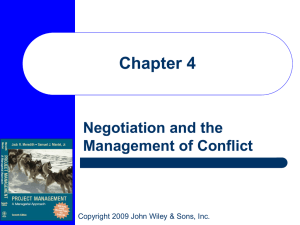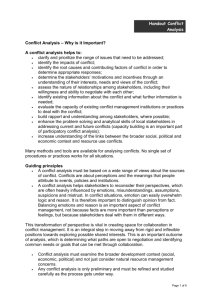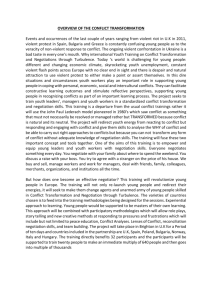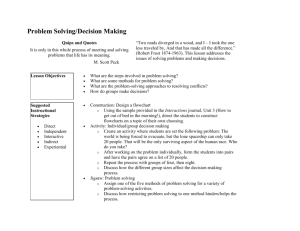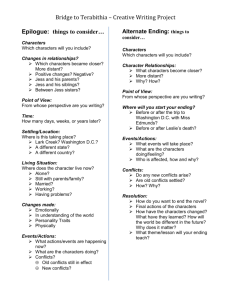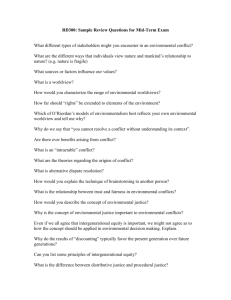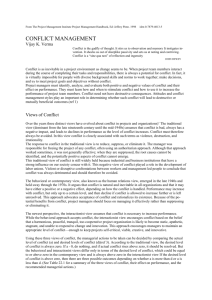E. Conflict Resolution
advertisement
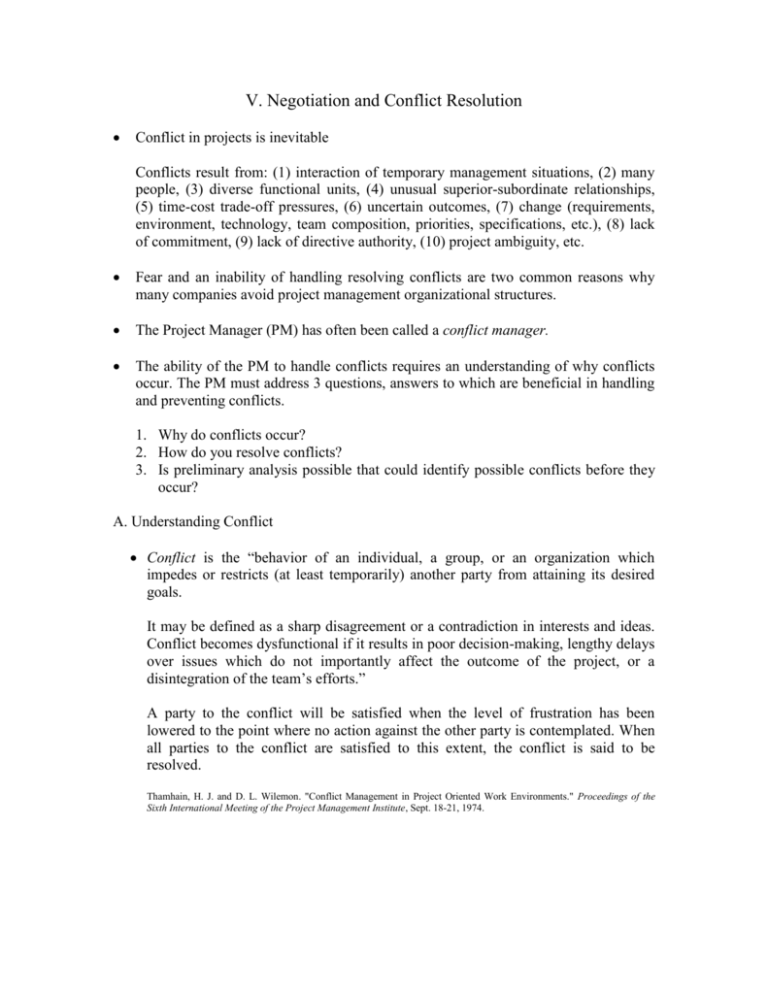
V. Negotiation and Conflict Resolution Conflict in projects is inevitable Conflicts result from: (1) interaction of temporary management situations, (2) many people, (3) diverse functional units, (4) unusual superior-subordinate relationships, (5) time-cost trade-off pressures, (6) uncertain outcomes, (7) change (requirements, environment, technology, team composition, priorities, specifications, etc.), (8) lack of commitment, (9) lack of directive authority, (10) project ambiguity, etc. Fear and an inability of handling resolving conflicts are two common reasons why many companies avoid project management organizational structures. The Project Manager (PM) has often been called a conflict manager. The ability of the PM to handle conflicts requires an understanding of why conflicts occur. The PM must address 3 questions, answers to which are beneficial in handling and preventing conflicts. 1. Why do conflicts occur? 2. How do you resolve conflicts? 3. Is preliminary analysis possible that could identify possible conflicts before they occur? A. Understanding Conflict Conflict is the “behavior of an individual, a group, or an organization which impedes or restricts (at least temporarily) another party from attaining its desired goals. It may be defined as a sharp disagreement or a contradiction in interests and ideas. Conflict becomes dysfunctional if it results in poor decision-making, lengthy delays over issues which do not importantly affect the outcome of the project, or a disintegration of the team’s efforts.” A party to the conflict will be satisfied when the level of frustration has been lowered to the point where no action against the other party is contemplated. When all parties to the conflict are satisfied to this extent, the conflict is said to be resolved. Thamhain, H. J. and D. L. Wilemon. "Conflict Management in Project Oriented Work Environments." Proceedings of the Sixth International Meeting of the Project Management Institute, Sept. 18-21, 1974. Conflict may have positive consequences on group processes and outcomes. Among other positive consequences, 1. It can lead to creativity and innovation. 2. It can lead to discovery of better solutions or a better understanding of another person. 3. It may assist professionals with the development of interpersonal problemsolving skills to handle conflict. 4. These interpersonal problem-solving skills center on identifying and stating the problem, seeking alternative solutions, exploring and testing alternative solutions, and selecting the best alternative. 5. These interpersonal problem-solving skills lead to the ability to develop of mutual trust and respect, candid communication, and awareness of the needs of others in relationships. Despite its benefits, conflict must be addressed as it can reduce or eliminate the possibility of achieving project goals. It is important that the PM possess skills to eliminate the source of the conflict as conflict avoiders do not make successful project managers. B. Project Conflict 1. Categories of Conflict The most common types of conflict involve: a. Schedules – timing of activities b. Priorities – sequence of activities within project and with other projects c. Labor Requirements/Responsibilities – frequently with departments that either assign personnel to project or support the project internally d. Technical Opinions/Issues – support functions are often responsible for technical inputs and performance standards, but not cost, schedule and performance objectives e. Administrative Procedures – e.g., PM’s authority and responsibilities, reporting relationships, status reviews, interorganizational interfacing, administrative support, etc. f. Personalities – difficult to deal with effectively g. Costs (estimates, capital expenditures) 2. Life Cycle - all phases of the life cycle experience these forms of conflict. a. Intensity over Project Life Cycle b. Trends of Conflict Intensity c. Major Conflict Source by Phase and Recommendations for Minimizing Dysfunctional Consequences C. Managing Conflict Conflict may be handled in several ways: (1) Mediation, (2) Arbitration, (3) Reduce Intensity, (4) Acceptance, (5) Elimination The key to resolving conflict rests on the PM’s ability to transform a “win-lose” situation into a “win-win” situation. It is important for the participants involved in the conflict to understand that conflicts occur between allies, not opponents. Conflict resolution requires collaboration in which the involved parties must rely upon one another. Otherwise, mistrust will prevail. D. Conflict Avoidance/Mitigation Mechanisms 1. Knowing potential conflict sources 2. Intensive planning may reveal potential conflict (e.g., scheduling, priority setting, resource allocation issues) 3. Project Charter a. Definition - a written agreement between the PM, senior management, and the functional managers that typically details the expected project deliverables, schedule, and budget. b. Purpose – to achieve agreement among project participants/stakeholders concerning what is to be done, when it is to be done, and at what cost. 4. Linear Responsibility Chart A responsibility matrix, used to clarify authority relationships by identifying participants and the extent of decision-making or task performance. The rows may be tasks in WBS, columns may be either positions, titles, or even people (avoid names if used externally) 5. Established Technical Change Order Process Given the uniqueness, unfamiliar nature, complexity of most projects, and professional nature of project participants, change is a necessity. This results in project delays and consequential scheduling complications. Problem: people are resistant to change and do not like having to perform a task more than once (replanning). An established technical change order process makes it easier to control inevitable changes and their frequency of occurring. The project participants need to be flexible and adaptive. 6. Managerial Style a. Participative Management (1) (2) (3) (4) (5) (6) (7) Promotes the ability of team members to manipulate tasks in order to meet project objectives Professionals do not like to be micromanaged It promotes creativity, enhances productivity, improves moral, promotes team spirit It emphasizes congruence with team’s and organization’s goals through norms of productivity, group cohesiveness (teamwork), and recognition from the quality of the team’s output Team members are held responsible and accountable for achieving project objectives Assists PM’s evaluation of team member performance Provides team member with timely feedback b. Listening, Caring, Involvement, and Rewarding: Professionals have a need to (1) be heard, (2) see their ideas have merit, (3) be involved, and (4) be rewarded for their efforts. c. Honesty and revealing feelings establishes and promotes credibility d. Body Language: Bodies reflect fear, boredom, interest, repulsion, openness, attraction, caring, hatred, etc. e. Prejudice locks the mind f. Concession: Helps establish credibility, and when coming from you it is not nearly as hurtful as an exposure coming from the “opponent” 7. Partnering (typically a vendor or subcontractor) a. Definition – “Partnering is a method of transforming contractual relationships into a cohesive, cooperative project team with a single set of goals and established procedures for resolving disputes in a timely and effective manner.”1 1 Cowen, C., C. Gray and E. Larson, "Project Partnering." Project Management Journal, December, 1992. b. Partnering Purpose - to avoid the natural adversarial relationship that exists between the organization’s objectives of achieving the desired outcome at lowest cost and the partner’s objectives of providing deliverable at greatest profit with the least effort. The intention is to replace the adversarial relationship with one built on cooperation and trust. c. Partnering Process (1) (2) (3) (4) (5) Joint evaluation Known method for resolving problems/disagreements Continuous improvement (kaizen) commitment Top management commitment to partnering Joint review of success upon project completion 8. Priorities Many executives feel the best way to avoid and resolve conflicts is with priorities. Problems: shifting priorities, large number of tasks with same “high” priority, no reason for priority given (concealed). E. Conflict Resolution 1. Company-wide conflict resolution policies and procedures 2. Project resolution procedures (est. during planning phase) 3. Hierarchical referral 4. Direct Contact On occasion, compromise appears to be helpful. But most often, it is typically best to confront friction between (among) project parties. Negotiation is the favored technique for resolving conflict. F. Negotiation - the favored technique for resolving conflict 1. Definition – “the process through which two or more parties seek an acceptable rate of exchange for items they own or control.” Wall, J. A, Jr. Negotiation: Theory and Practice. Glenview, IL: Scott Foresman, 1985. PM must seek an outcome that will improve the stance of the involved parties while achieving organizational (and hence project) goals. 2. Fisher and Ury's “Principled Negotiation” - 4 points a. Separate the people from the problem: Define the substantive problem as emotions and fact get confused b. Focus on interests, not positions: Positions tend to exhibit demands, interests allow for movement in an equitable settlement c. Invent Options for Mutual Gain: Advance the mutual interests of the conflicting parties, search for settlement that “saves face” d. Use objective criteria or standards to determine the quality of an outcome (e.g., expert opinion, company policy, market value, competitive benchmarks, etc.) 3. Negotiation Methods (Blake and Mouton) a. Withdrawal: refraining and retreating from an argument b. Smoothing: Playing down the differences and emphasizing common interests and subsequently avoiding issues that may cause divisions and hurt feelings c. Compromise: Splitting the difference, bargaining, or searching for an intermediate position (no one loses, but no one wins) d. Forcing: A win-lose situation, participants are antagonists, creates a victor and a vanquished e. Confrontation: An open exchange of information about conflict or a problem as each participant sees it, and working through their differences to reach a solution that is equitable to both. It's a win-win solution that is sought. The following solution characteristics are necessary: (1) (2) (3) (4) (5) (6) (7) (8) (9) (10) (11) (12) (13) (14) Both parties have vested interest in the outcome Both parties realize that collaboration has the potential to resolve the matter in an equitable fashion Recognition that conflict occurs, it must be defined by those in the relationship, and solutions must be generated by those who share the responsibility for assuring the solution will work satisfactorily Goal must be to solve the problem, not to accommodate different points of view Parties involved must be flexible Must be a realization that both sides of controversy have potential strengths and weaknesses Must be an effort to understand and accept the other party's side Must look at conflict from objective viewpoint Examine one's own attitudes (hostilities) before interpersonal contact can become effective An understanding of the less effective negotiation methods (1-4) is necessary Face saving solutions are important (allow people to give so that a change in one’s viewpoint isn't perceived as being weak or as capitulation) May need to minimize effects of status differences, defensiveness, prejudices, and other barriers which prevent people from working together effectively Be aware of limitations of arguing Be aware of limitations of downgrading opponent's position Favored Modes of Conflict Resolution 4. Negotiation Methods Survey Results Survey of 57 managers, described interpersonal conflicts having either a good or bad resolution. 70% response rate 5. Negotiation method used depends upon parties in conflict 6. PM’s “methods of influence” as a means of reducing potential conflicts
